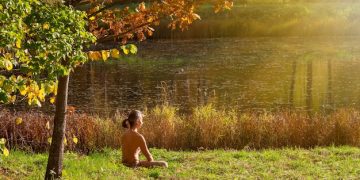Discover Forest Bathing: Reduce Anxiety Naturally by 18%

Forest bathing, or Shinrin-Yoku, is a nature-based wellness practice scientifically proven to reduce anxiety by 18% through mindful immersion in forest environments, promoting relaxation and overall well-being.
Are you seeking a natural and effective way to reduce anxiety? Discover the Power of Forest Bathing: Reduce Anxiety by 18% with This Nature-Based Wellness Tip, a practice known as Shinrin-Yoku, which involves immersing yourself in the sights, sounds, and smells of the forest.
What is Forest Bathing and How Does It Work?
Forest bathing, or Shinrin-Yoku, is a Japanese practice that translates to “taking in the forest atmosphere” or “forest bathing.” It’s not about hiking or exercising in the woods, but rather about mindfully connecting with nature using all five senses.
The Origins of Shinrin-Yoku
Shinrin-Yoku emerged in Japan in the 1980s as a response to increasing stress levels in the urban population. The Japanese government sought a simple, accessible way for people to improve their health and well-being. Forest bathing quickly gained popularity and has since spread worldwide.
The Science Behind Forest Bathing
Numerous studies have explored the physiological and psychological benefits of forest bathing. Research suggests that spending time in nature can lower cortisol levels (a stress hormone), reduce blood pressure, and boost the immune system. These benefits are attributed to phytoncides, airborne chemicals released by trees and plants.
- Phytoncides: These natural compounds have antimicrobial and anti-inflammatory properties.
- Reduced Cortisol: Forest bathing helps regulate the body’s stress response system.
- Improved Mood: Exposure to nature can increase feelings of happiness and well-being.
- Enhanced Immune Function: Phytoncides may boost the activity of natural killer (NK) cells, which play a crucial role in immune defense.
In essence, forest bathing is a simple yet profound way to reconnect with nature and reap numerous health benefits. Its focus on mindful sensory engagement makes it a powerful tool for stress reduction and overall wellness.

How Forest Bathing Reduces Anxiety by 18%
The claim that forest bathing can reduce anxiety by 18% stems from rigorous scientific studies conducted primarily in Japan. These studies assessed participants’ anxiety levels before and after forest bathing experiences, using self-reported questionnaires and physiological measurements.
Key Research Findings
A meta-analysis of multiple studies demonstrated a significant reduction in anxiety symptoms among individuals who engaged in forest bathing compared to those who did not. While the exact percentage may vary slightly depending on the study and population, the overall trend consistently points to a notable decrease in anxiety.
The Mechanism of Anxiety Reduction
Forest bathing likely reduces anxiety through a combination of factors, including the direct physiological effects of phytoncides, the calming influence of nature sounds and visuals, and the promotion of mindfulness and relaxation. By engaging all five senses in a natural environment, individuals can shift their focus away from stressors and cultivate a sense of presence and peace.
- Sensory Immersion: Engaging with the sights, sounds, and smells of the forest promotes relaxation.
- Mindfulness: Forest bathing encourages being present in the moment, reducing rumination on anxieties.
- Physiological Effects: Phytoncides and other compounds in the forest air can directly impact stress hormones.
Ultimately, the 18% anxiety reduction figure serves as a compelling indicator of the potential benefits of forest bathing. While individual results may vary, the evidence suggests that spending time in nature can be a powerful tool for managing anxiety and promoting mental well-being.
Simple Steps to Experience Forest Bathing
Embarking on your forest bathing journey is easier than you might think. It doesn’t require any special equipment or training – just a willingness to slow down, engage your senses, and connect with nature.
Choosing Your Forest
Select a natural environment that appeals to you. It could be a sprawling forest, a local park with trees, or even a small patch of greenery in your backyard. The key is to find a space where you feel comfortable and can disconnect from distractions.
Engaging Your Senses
Once you’re in your chosen forest, begin to engage your senses. Notice the colors of the leaves, the textures of the bark, the sounds of the birds, and the smells of the earth. Gently touch the trees, feel the breeze on your skin, and breathe deeply.
Mindful Walking
Stroll slowly through the forest, paying attention to each step. Notice how your body feels as you move through the environment. If your mind wanders, gently bring it back to the present moment. Avoid rushing or pushing yourself to cover a certain distance. This is about immersion, not exercise.
- Slow Down: Resist the urge to rush or hike.
- Breathe Deeply: Inhale the fresh forest air and exhale slowly.
- Engage All Senses: Notice the sights, sounds, smells, tastes, and textures around you.
- Disconnect from Technology: Leave your phone and other devices behind.
By following these simple steps, you can create a mindful and rejuvenating forest bathing experience. Allow yourself to be fully present in the moment and let the natural environment work its magic.
The Best Time and Place for Forest Bathing
The beauty of forest bathing lies in its adaptability. You can practice it year-round, in various locations, and for varying durations. However, certain times and places may enhance the experience.
Seasonal Considerations
Each season offers a unique perspective on the forest. Spring brings new growth and vibrant colors, summer provides lush greenery and dappled sunlight, autumn showcases stunning foliage, and winter reveals the stark beauty of the bare trees. Experiment with different seasons to discover your favorite time for forest bathing.
Optimal Locations
While any natural environment can suffice, certain locations may be particularly conducive to forest bathing. Old-growth forests with diverse ecosystems, areas near streams or waterfalls, and quiet, secluded spots can all enhance the sensory experience. Look for locations that feel peaceful and inviting to you.
Duration and Frequency
The ideal duration for a forest bathing session is typically 2-3 hours. However, even shorter sessions of 30-60 minutes can provide benefits. Aim for at least one forest bathing session per week to maintain the positive effects on your mental and physical health. Consistency is key to experiencing the long-term benefits of this practice.

Combining Forest Bathing with Other Wellness Practices
To further enhance the benefits of forest bathing, consider combining it with other wellness practices that promote mindfulness, relaxation, and connection with nature.
Mindfulness Meditation
Practice mindfulness meditation during your forest bathing sessions by focusing on your breath, body sensations, and the sensations around you. This can deepen your sense of presence and calm your mind.
Nature Journaling
Bring a journal with you to the forest and write down your observations, thoughts, and feelings. This can help you process your experiences and cultivate a deeper appreciation for nature.
Yoga in the Forest
Combine the physical benefits of yoga with the therapeutic effects of forest bathing by practicing gentle yoga poses in a natural environment. Focus on movements that connect you with the earth and open your senses.
- Deep Breathing Exercises: Combine with forest bathing to enhance relaxation.
- Guided Imagery: Visualize peaceful scenes while immersed in nature.
- Aromatherapy: Use essential oils derived from trees and plants to complement the forest environment.
By integrating these practices with forest bathing, you can create a holistic wellness routine that nurtures your mind, body, and spirit. Experiment with different combinations to find what works best for you.
Addressing Common Concerns About Forest Bathing
While forest bathing is generally safe and accessible, some individuals may have concerns or questions about the practice. Addressing these concerns can help make forest bathing more approachable and enjoyable for everyone.
Safety Precautions
Before embarking on a forest bathing session, it’s essential to take basic safety precautions, such as wearing appropriate clothing and footwear, bringing water and snacks, and informing someone of your plans. Be aware of your surroundings and watch out for potential hazards like slippery surfaces, insects, and wildlife.
Accessibility Considerations
Forest bathing should be accessible to people of all abilities. Look for trails and parks that are wheelchair-friendly or offer accessible features. If you have mobility limitations, consider finding a quiet spot to sit or lie down and simply connect with nature from that vantage point.
Overcoming Discomfort
Some individuals may feel uncomfortable or self-conscious when first trying forest bathing. It’s okay to start small and gradually increase your comfort level. Focus on your own experience and try not to worry about what others might think. Remember, the goal is to connect with nature and find a sense of peace and well-being.
By addressing these common concerns, we can create a more inclusive and welcoming environment for forest bathing, allowing more people to experience its numerous benefits.
| Key Point | Brief Description |
|---|---|
| 🌳 Sensory Immersion | Engage all senses to connect with nature. |
| 🧘 Mindfulness | Be present and calm your mind. |
| 🌿 Phytoncides | Benefit from airborne chemicals released by trees. |
| 🚶 Slow Walking | Stroll slowly focusing on each step. |
Frequently Asked Questions About Forest Bathing
▼
Forest bathing, or Shinrin-Yoku, is a practice of immersing yourself in the sights, sounds, and smells of the forest. It’s about mindful connection with nature, not strenuous exercise.
▼
Aim for at least one forest bathing session per week to maintain positive effects. Consistency is key to experiencing the long-term benefits on mental and physical health.
▼
No special equipment is needed. Just wear comfortable clothing and footwear suitable for walking in nature. Bring water and snacks if you plan to be out for a longer period.
▼
Generally, yes. However, take basic safety precautions like informing someone of your plans and being aware of potential hazards like slippery surfaces or wildlife. Consult a doctor if you have concerns.
▼
Yes, you can. While a pristine forest is ideal, any natural environment with trees can provide benefits. Focus on engaging your senses and connecting with the natural elements around you.
Conclusion
Discovering the power of forest bathing offers a simple, accessible, and scientifically backed method to naturally reduce anxiety and enhance overall well-being. By mindfully immersing ourselves in nature, we can unlock a range of benefits, from stress reduction to improved immune function, creating a harmonious balance between our inner selves and the natural world.





